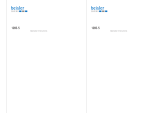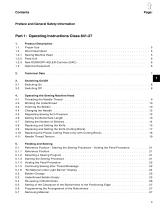
1.2 Technical Specification
Nominal voltage: Standard machine
3x380-400V+N, 50 Hz
The nominal voltage (operating voltage) for which
the sewing unit was set up is shown on the plate
attached to the spar at the front left under the table
top.
For operation with other mains voltages the
information contained in the enclosed connection
diagram 9870 744001 B must be strictly adhered to
and the necessary connection changes made.
Depending on the mains voltage and cycle the
necessary modification parts, e.g. pulley, V-belt,
protection switch insert,etc. are available under the
following order no.s:
3x380-400V+N 50 Hz - 744 100121
3x220-230V 50 Hz - 744 100122
3x220-230V 60 Hz - 744 100123
3x415V+N, 50 Hz - 744 100124
Machine Head
– One needle-dual chain stitch Stitch type 401
– Class 935-933-200
– with controlled thread trimmer on the base plate
– Number of stitches: adjustable between
3800-5400 stitches/min.
– Stitch length: adjustable for 2,1 mm,
2,5 mm, 3,0 mm or 3,6 mm
– Stitch length by stitch condensing: 2,0 mm,
1,5 mm or off
– Needle system: 934 SIN
Sewing Lengths
Depending on the equipment, the maximum sewing
length can be either 1000 mm or 1250 mm.
Appropriate transport drive parts and material
guide rails make possible a quick conversion.
Material Guide Rail
The left, right and wait positions can be selected
with the control unit. The wait position keeps the
feed area clear.
The return speed of the material guide rail can be
reduced through a coding. It is dependent on the
form of the material guide rail.
The rail clearance stroke is 30 mm.
Compressed Air :
Operating pressure: 6 bar
Air consumption: approx. 9 NL per operating cycle
Vacuum:
The sewing unit is prepared for connection to an
in-house vacuum facility. If this is not available then
a rotary blower must also be ordered.
For 3 x 380-400V+N, 50 Hz - Order no.722 3031K
For 3 x 415V+N, 50 Hz _- Order no.722 3032K
For 3 x 220-230V, 50 Hz - Order no.722 3033K
For 3 x 220-230V, 60 Hz - Order no.722 3034K
For 3 x 220V, 50 Hz - Order no.722 3035K
Dimensions: Width: 3600 mm (2100 mm)
Depth: 1000 mm (1000 mm)
Height: 1500 mm to top of
_ control unit (1400 mm)
( ) = Shipping dimensions
The sewing unit (work level) is height adjustable
from 920-1140 mm for standing operation.
1.3 Optional Equipment
Order no.
794 7451 Side table
935 - - - - Edge cutter and chain trimmer
935 20607 Throat plate with stitch hole 1,5x5 mm
935 20608 Throat plate with stitch hole 1,8x5 mm
4
















